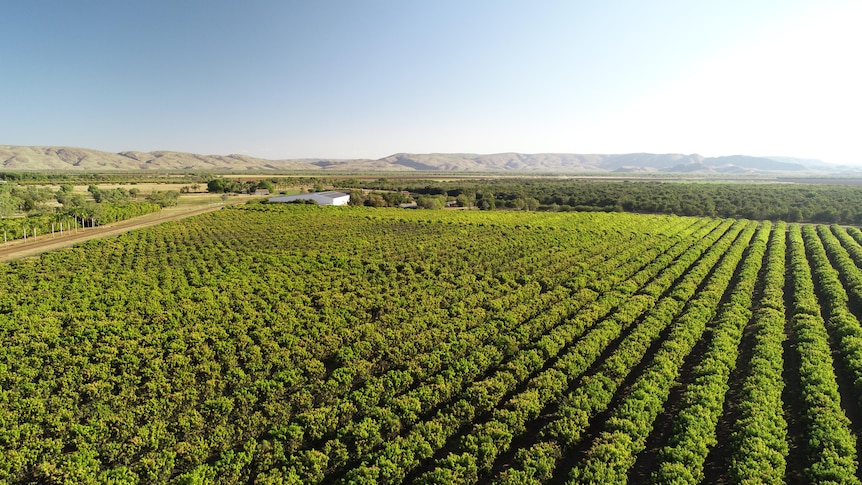The recent spread of foot-and-mouth disease to Indonesia is not the only biosecurity battle for which farmers in WA’s easternmost agricultural region are bracing.
Key points:
- WA’s first detection of myrtle rust has been confirmed in the East Kimberley
- Sandalwood producer Santanol has put the trial of a promising new crop on hold
- There has been a 50 per cent jump in quarantine material collected at the WA/NT border
As the only growing region in WA that sits on an interstate border, the Ord Valley’s irrigated horticulture, broadacre cropping and sandalwood industries are on high alert as several dangerous pests and plant diseases creep further west.
Located just 40 kilometers from WA’s border with the Northern Territory on the outskirts of Kununurra, it is no stranger to biosecurity incursions.
It’s where the cane toad first crossed into the state more than a decade ago, and where the damaging fall armyworm affected the first WA broadacre crops in 2020.
It’s also close to where myrtle rust was found for the first time two months ago.
It’s feared mango shoot looper and banana freckle disease could be next after they were each detected in the Northern Territory this year.
Promising new project on hold
Sandalwood producer Santanol is among the hardest hit by the detection of myrtle rust on an East Kimberley pastoral station in June.
Myrtle rust is a fungal disease that can infect and kill plants in the myrtaceae family, such as eucalypts, bottlebrushes, paperbarks and peppermint trees.
While the disease poses no threat to Santanol’s primary sandalwood operation near Kununurra, a new pilot project targeting the cut flower and aromatic oil markets has been put on hold as a result of its spread to WA.
For commercial reasons, Santanol is remaining tight-lipped on the plant species being used in the pilot, but has confirmed it is part of the myrtaceae family.
Managing director David Brocklehurst said plans to expand the crop into broadacre trials this dry season were now too risky.
“We are very concerned that if the rust gets here and we’ve just planted 100,000 plants, then we would actually end up having nothing,” Mr Brocklehurst said.
“We’re keeping the plants well-quarantined and we’ll just see how this unfolds.”
The Department of Primary Industries said there had been no further detections of myrtle rust since its initial detection in June.
Horticulture sector on alert
Meanwhile, the recent spread of mango shoot looper to the Northern Territory and detections of varroa mite in New South Wales has put Ord Valley mango growers on edge.
Mango shoot looper is an invasive pest that attacks mango and lychee plants while the varroa mite targets bees, which play a key role in the pollination of a variety of horticultural crops.
Swag Rural manager Steve Angel, who looks after WA’s biggest mango orchard on the outskirts of Kununurra, said he had limited vehicle movements across the property.
Mr Angel said he was also conducting regular checks of the orchard to ensure there was no sign of the pests.
He said the spread of either disease into WA would be devastating.
“If we didn’t control them and have preventive measures, there would be no sense being here,” Mr Angel said.
“People have got to be on the front foot and be aware, not on the back foot waiting for something, making contingency plans.
“We want to keep it out.”
Quarantined volumes soar
Officers at the Department of Primary Industries and Regional Development’s quarantine checkpoint near Kununurra are the last line of defense in protecting the region from threats looming across the border.
According to new figures for the 2021-22 financial year, more than 14,000 kilograms of quarantine risk material was detected at the checkpoint, up more than 50 per cent from the previous year.
Supervising inspector Kenneth Bin Jacob said while the lifting of WA’s COVID-19 border restrictions largely contributed to the jump, the long-term trend showed more risk material was collected each year.
“We do see an increase each year — a slight increase,” he said.
“It never really goes backwards.”
Agriculture Minister Alannah MacTiernan said the state government had increased its biosecurity efforts in response to the outbreaks of plant diseases and pests in the Northern Territory.
“We are very aware of the risks of banana freckle and mango shoot looper and we’re working with the growers to up both our surveillance and our movement control,” she said.
“We’re also developing a broader biosecurity awareness program that we’ll be aiming at the punters, making sure that people understand that they’ve got a role to play.”
The heightened plant biosecurity concerns come at a time when Kimberley pastoralists are on alert for animal infections that have spread to Indonesia, including foot and mouth disease and lumpy skin disease.
.

